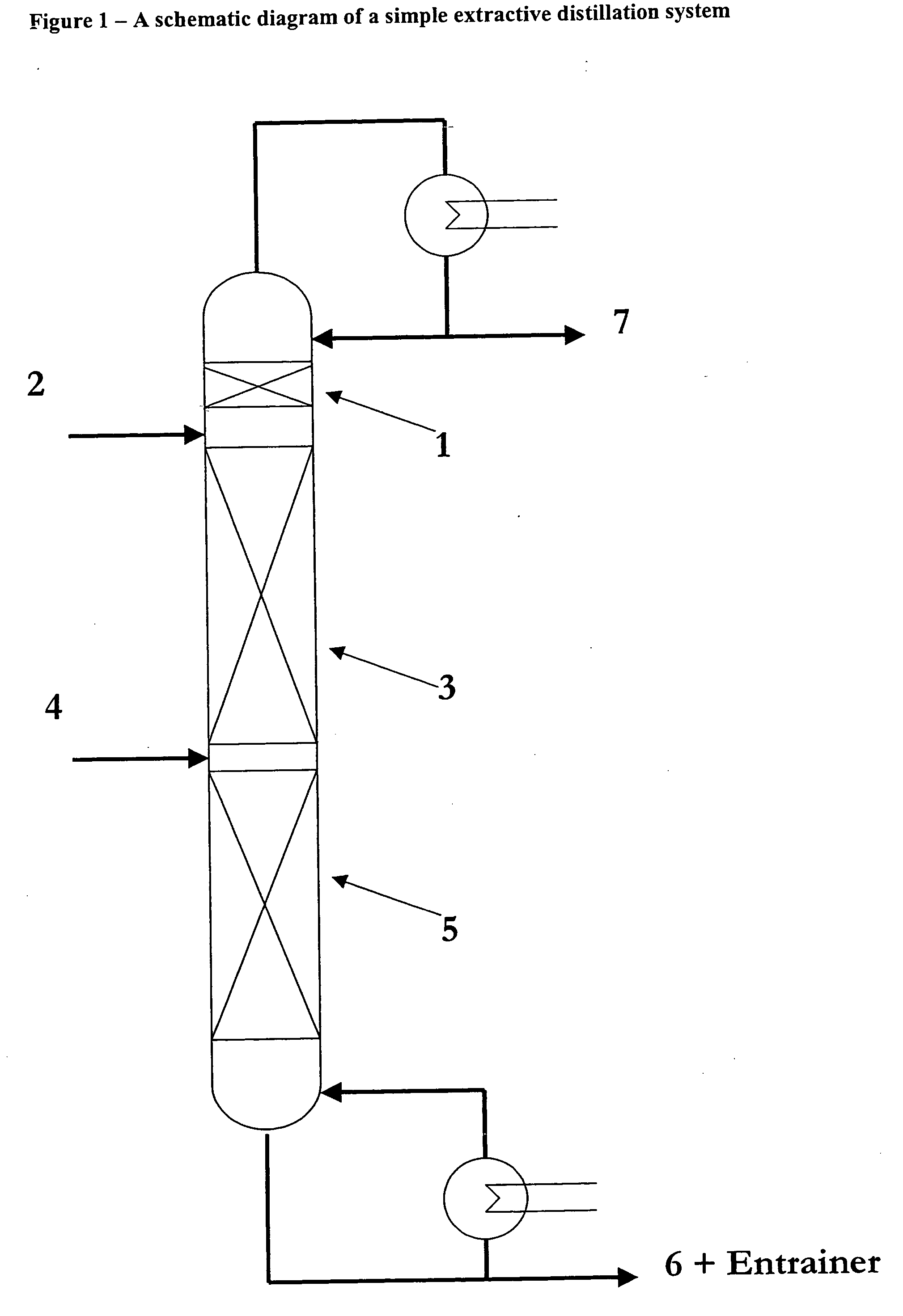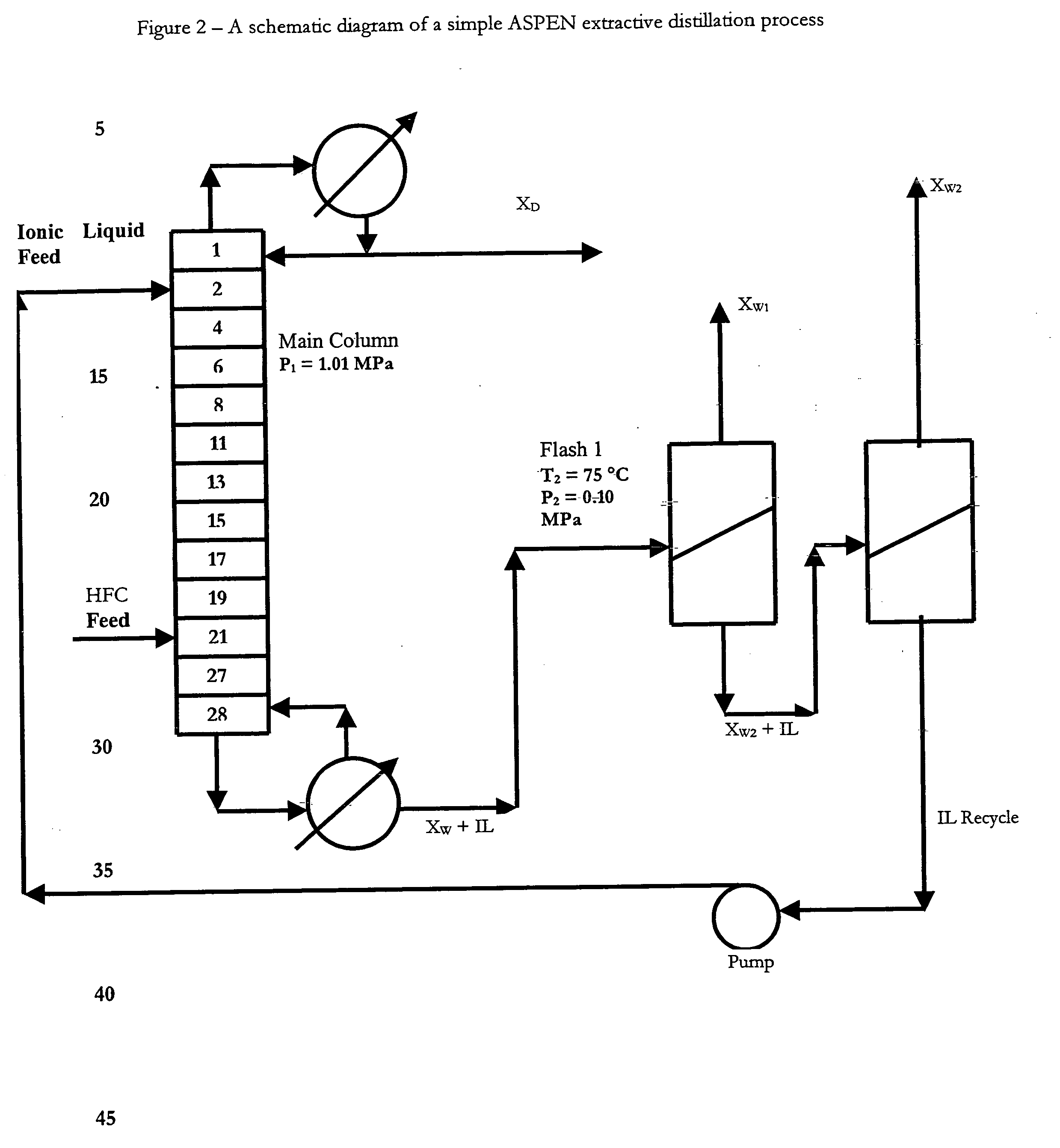Utilizing ionic liquids for hydrofluorocarbon separation
a technology of hydrofluorocarbon separation and ionic liquid, which is applied in the direction of halogenated hydrocarbon preparation, separation process, azeotropic distillation, etc., can solve the problem that the close-boiling mixture cannot be easily separated by conventional distillation
- Summary
- Abstract
- Description
- Claims
- Application Information
AI Technical Summary
Benefits of technology
Problems solved by technology
Method used
Image
Examples
example 1
Selectivity Ratio
[0384] Infinite activity coefficients and selectivities are shown for several refrigerants in Table 2. The selectivity is calculated relative to HFC-32 in 1-butyl-3-methylimidazolium hexafluorophosphate, [bmim][PF6]. Standard activity coefficient models (S. I., Sandler, Chemical and Engineering Thermodynamics, 3rd Edition (1999) John Wiley and Sons, Inc., New York, Chapter 7) were used to fit solubility data in order to calculate the infinite activity coefficients.
[0385] As shown, HFC-134a, HFC-152a, HFC-125 and HFC-143a have selectivity values well above 2.0, which suggest that a separation of these compounds from HFC-32 by extractive distillation is feasible using [bmim][PF6] as the entrainer.
[0386] The solubility curves for these refrigerant pairs are shown in FIGS. 3 to 8 at constant T of 10, 25, 50, and 75° C. The differences in the solubility curves for each hydrofluorocarbon tested can be described by plotting the pressure (P) divided by the saturation pr...
example 2
Separation of a Mixture Comprising Difluoromethane and Pentafluoroethane
[0388] An Aspen Plus® process simulation was used to model the extractive distillation process for the separation of a mixture consisting of difluoromethane and pentafluoroethane using [bmim][PF6] as the entrainer. The Aspen flowsheet used for this simulation consists of a main column modeled with RadFrac and two outlet flash drums for the regeneration of the ionic liquid (IL), which is recycled back into the main column as shown in FIG. 2. The immeasurable vapor pressure of the ionic liquid was taken into consideration by fitting the Extended Antoine equation value close to zero. The ionic liquid was treated as a non-dissociating component and assumption of an ideal vapor phase was made, therefore, the investigated Vapor-Liquid Equilibrium (VLE) data could be described by the liquid concentration and activity coefficient. Nonrandom two-liquid (NRTL) binary interaction parameters (S. I., Sandler, Chemical and ...
example 3
Solubility of difluoromethane (HFC-32) in 1-butyl-3-methylimidazolium hexafluorophosphate
[0398] A solubility and diffusivity study was made at temperatures of 10, 25, 50, and 75° C. over a pressure range from 0 to 10 bar where the solubilities (Xmeas.) were measured using a gravimetric microbalance and the diffusivities (D) were calculated using a one-dimensional diffusion model analysis. The initial concentration (Co), final saturation concentration (Cs), and calculated solubility (Xcalc.) are also provided.
[0399] Tables 4a, 4b, 4c and 4d provide data for Co, Cs, D, Xcalc, and Xmeas at temperatures of 10, 25, 50 and 75° C., respectively.
TABLE 4aCoXcalc.Xmeas.TP(massCsD(mol.(mol.(° C.)(bar)%)(mass %)(m2 / sec)fraction)fraction)10.00.09790.520.541.54E−090.0290.02610.00.99570.822.531.94E−110.1240.10610.02.49673.327.561.71E−110.3090.27010.03.99648.1812.383.65E−110.4360.42610.05.497514.4418.716.34E−110.5570.55510.06.996522.1227.857.42E−110.6780.67610.08.4954————0.812
[0400]
TABLE 4bCoXc...
PUM
| Property | Measurement | Unit |
|---|---|---|
| boiling points | aaaaa | aaaaa |
| boiling points | aaaaa | aaaaa |
| pressure | aaaaa | aaaaa |
Abstract
Description
Claims
Application Information
 Login to View More
Login to View More - R&D
- Intellectual Property
- Life Sciences
- Materials
- Tech Scout
- Unparalleled Data Quality
- Higher Quality Content
- 60% Fewer Hallucinations
Browse by: Latest US Patents, China's latest patents, Technical Efficacy Thesaurus, Application Domain, Technology Topic, Popular Technical Reports.
© 2025 PatSnap. All rights reserved.Legal|Privacy policy|Modern Slavery Act Transparency Statement|Sitemap|About US| Contact US: help@patsnap.com



